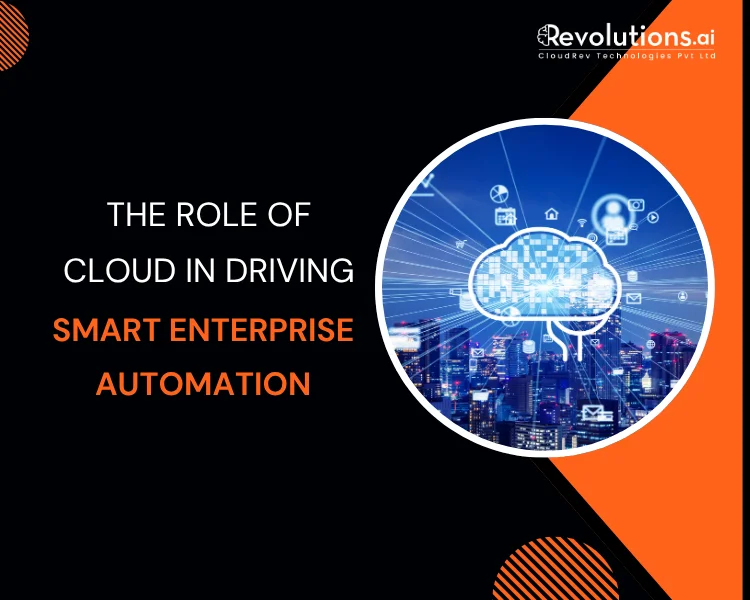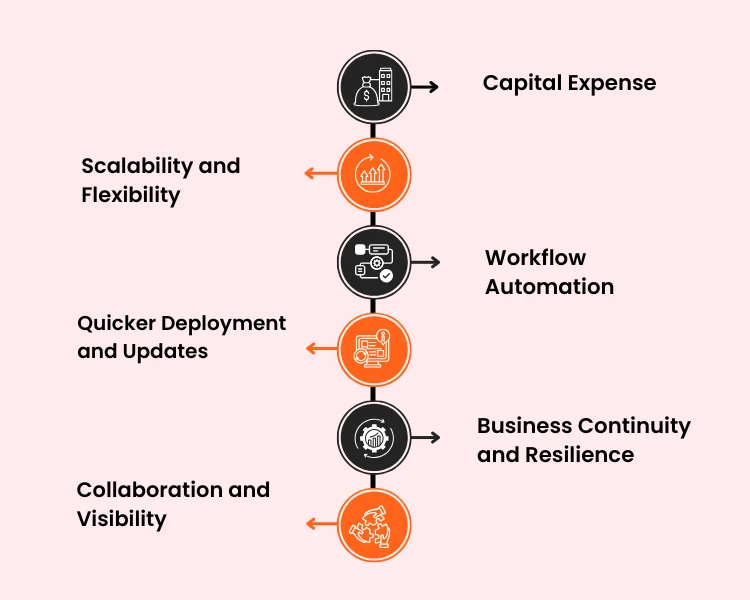Let’s face it, every business in today’s day wishes to speed up, work more efficiently, and cut down on the clutter behind the scenes. But getting to that level of smoothness doesn’t happen overnight without the support mechanism. It’s where cloud enterprise automation, powered by today’s technology, comes into play. From automating everyday operations to facilitating instant decision-making, the cloud is becoming the resource of choice for organisations trying to remain agile and in line with the times.
As companies grow, they require more than simple manual processes and fragmented integration. Intelligent enterprise automation brings in intelligent solutions such as AI, machine learning, and robotic process automation (RPA) to refine everything from customer service to supply chain operations. When deployed in a nimble, elastic platform, companies can break down silos, minimize human error, and react to market changes in real time.
In this blog, we’ll explore how enterprise automation is transforming the way businesses operate. From enabling real-time collaboration to delivering data-driven decisions and cost efficiency, it is reshaping the core of modern enterprises, making them smarter, faster, and future-ready.
Why are Enterprises Shifting Automation to the Cloud?
The business world today requires agility, speed, and cost-effectiveness that further attributes on-premise systems. However, enterprises are now turning to cloud-based solutions to meet these requirements. With the cloud environment providing unparalleled flexibility, companies can now automate processes at scale without having to invest in heavy infrastructure or lengthy deployment cycles.
One of the largest impetuses for this transition is the demand for instant access and cross-functional collaboration. Within cloud environments, automation processes can be controlled and integrated centrally with other software tools. This not only minimizes manual intervention and lag but also maximizes overall visibility and accountability across the organization.
In addition, automation cloud tools allow companies to test, iterate, and innovate rapidly. Upgrades, patches, and feature improvements can be rolled out with little interruption so that automation remains in sync with changing business requirements. Also, pay-as-you-go pricing models and this flexibility make the cloud a strategic decision for companies seeking to future-proof their automation strategy.
What are the Key Benefits of Cloud-Driven Automation?
Cloud-based automation is changing the way contemporary companies do business, providing a scalable and elastic platform to automate processes, eliminate inefficiencies, and fuel growth. With cloud-powered enterprise workflows, organizations have the capability to automate processes within different departments as well as ensure the integration of these processes with other digital offerings without the limitations of on-premise systems.
- Scalability and Flexibility
Cloud automation platforms enable businesses to scale their operations up or down depending on demand. Whether automating a handful of internal processes or executing complex, company-wide procedures, companies can scale resources on the fly without the necessity for new hardware or involved installations. - Capital Expense
Without a heavy initial investment in infrastructure, cloud automation brings down capital expense by a considerable amount. Pay-as-you-go services mean organizations only pay for what is consumed, which makes automation more viable for startups and large enterprise levels as well. - Quicker Deployment and Updates
Cloud-hosted automation tools can be implemented in days rather than weeks. Regular feature drops and updates guarantee organisations are continuously leveraging the newest capabilities without impacting running operations. - Collaboration and Visibility
Cloud platforms offer centralized control panels and dashboards, enabling teams remote and local to monitor, maintain, and improve automated processes in real time. This creates higher transparency and guarantees alignment between business functions. - Workflow Automation
By integrating automation with artificial intelligence, cloud infrastructure allows for smarter workflows that learn, adapt, and optimise through real-time data. AI workflow automation allows businesses to go beyond the manual rules-based work and make informed decisions at a much faster pace. - Business Continuity and Resilience
Cloud automation accommodates remote operations, disaster recovery, and real-time backup. It ensures that core processes continue to run smoothly even in the event of unforeseen interruptions, keeping customer service and internal stability intact.
What Security Measures are Necessary for Cloud-Based Automation?
With organisations choosing cloud-based automation, securing data, processes, and infrastructure takes centre stage. Also, automation tends to entail access to sensitive data; hence, the need to have strong authentication controls like multi-factor authentication (MFA), role-based access controls (RBAC), and encrypted communication channels. These foundational security practices prevent unauthorized access and data breaches, ensuring that trusted users and systems are the ones that can trigger or run automated workflows.
Apart from access control, monitoring and auditing are key to ensuring a secure environment. Also, monitoring automation activities in real time enables the detection of unusual activity or possible threats in advance. Also, logging and audit trails must be created automatically for all actions performed by bots or systems, enabling visibility and traceability to assist with compliance reporting and post-incident analysis.
For a digital enterprise, the job doesn’t finish with initial configuration. Regular vulnerability scanning, security updates, and adherence to worldwide data protection laws (such as GDPR or HIPAA) are a must. Through the incorporation of security into each aspect of automation architecture, companies can establish trust, guarantee resilience, and have a strong countermeasure against the changing cybersecurity terrain.
What Trends are Shaping the Future of Cloud Enterprise Automation?
The future of business automation is being determined through a swift convergence of technologies, changing business goals, and increasing pressure for real-time responsiveness. The most impactful trend is the emergence of hyperautomation, a practice more comprehensive than conventional automation that integrates AI, machine learning, robotic process automation (RPA), and data analytics. This practice allows organizations to not only automate routine tasks but also intricate decision-making processes, making more intelligent and more responsive systems.
Yet another characteristic trend is shifting towards low-code and no-code automation platforms. They enable business users and non-IT teams to create and deploy automated processes without intricate coding. Consequently, automation is not anymore an IT-only affair but is emerging as a cross-functional effort, driving digital transformation across the whole organization. This democratisation of automation makes quick innovation, shorter development cycles, and more specific solutions for precise business requirements possible.
Furthermore, combining automation with cloud-native architectures is making it possible for higher scalability, flexibility, and remote accessibility. Also, enterprises are also placing emphasis on AI-based analytics in automation tools to create real-time insights, predict results, and continually optimize workflows. As these patterns develop, cloud enterprise automation is transforming from a tactical tool for efficiency to a strategic driver of innovation, customer experience, and competitiveness.
What is the Difference Between Cloud Agility and Automation Success?
Cloud agility is a core driver of enterprise automation success by facilitating quicker adaptation to change, tool integration without issues, and quick deployment of new solutions. With cloud infrastructure that is flexible, companies are able to scale automation quickly and adapt to changing market conditions. It further utilizes more intelligent operations based on real-time optimization and decision-making.
- Quicker Deployment and Updates: Cloud platforms enable fast deployment of automation software and workflows, minimizing time-to-value and enabling quick response by teams to new business requirements.
- On-Demand Scalability: Cloud resources are scalable up or down in seconds, allowing automation processes to expand with business operations without latency or system overload.
- Flexible Integration: Cloud platforms facilitate simpler integration with different APIs, SaaS applications, and data sources so that automation can extend across departments and functions seamlessly.
- Remote Accessibility: With cloud-hosted automation, groups are able to manage and track workflows remotely, supporting hybrid and distributed workforces while still having control and efficiency.
- Continuous Improvement and Testing: Agile cloud configurations allow for the simpler testing of new automation models, collection of feedback, and fast iteration, leading to smarter, more responsive systems.
- Cost and Resource Efficiency: Through avoidance of initial infrastructure expenses, organizations can better utilize their budgets, focusing resources on innovation and scaling automation strategically.
Conclusion
The business operations of the future are being redefined by the integration of cloud technology and smart automation without any seams. With increased speed, agility, and affordability, cloud enterprise automation is making organizations achieve new levels of productivity and creativity. By automating manual steps and facilitating decision-making in real-time using data, enterprises are more capable of competing in today’s rapidly changing world.
At Revolution AI, we help organisations use the maximum power of cloud-based automation with customized strategies, scalable solutions, and smart systems. We are committed to creating automation solutions that are not only efficient but also future-proof. This is further built to change with business demands. We even believe in changing enterprises to remain agile, simplify complexity, and attain operational excellence through wiser automation.
Frequently Asked Questions
Cloud business automation is the employment of cloud platforms and solutions to automate business processes within an organization. It optimizes operations, minimizes manual intervention, and improves scalability through cloud-based infrastructure.
In contrast to conventional on-premises automation, automated cloud operations allow more flexibility, quicker deployment, and seamless integration with other cloud services. Enterprise automation also facilitates remote access, instant updates, and more economical scaling.
Yes, the majority of cloud automation platforms provide enterprise-level security features such as encryption, multi-factor authentication, and adherence to industry standards such as GDPR, HIPAA, and ISO certifications. Regular audits and monitoring add another layer of security.
Typical processes are data entry, invoice processing, customer onboarding, IT workflows, HR operations, and report generation. Cloud platforms enable automation across departments using customizable workflows.
Popular tools are robotic process automation (RPA), AI-powered analytics, low-code platforms, workflow builders, and integration hubs. These tools combine to build intelligent, end-to-end automated solutions in the cloud.

Hemal Sehgal
Introducing Hemal Sehgal, a talented and accomplished author with a passion for content writing and a specialization in the blockchain industry. With over two years of experience, Hemal Sehgal has established a strong foothold in the writing world, c...read more




